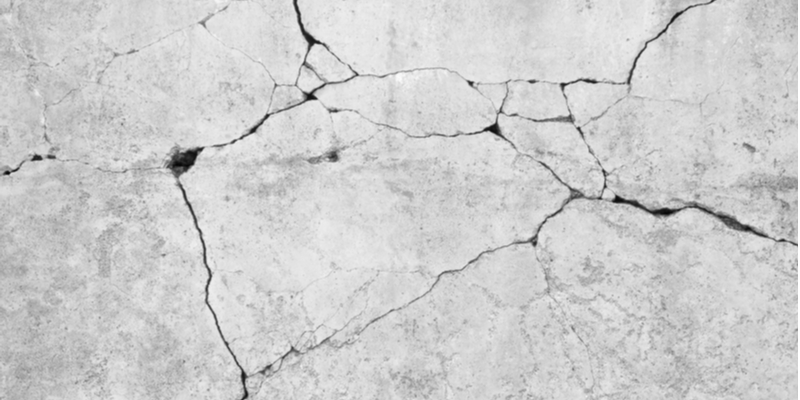Concrete cracks are incredibly common, but did you know there are many different types of concrete cracks? The type of crack signifies how severe it is and what (if any) repairs need to be conducted.
Some common types of concrete cracks include plastic shrinkage cracks, expansion cracks, cracks related to heaving, settling cracks, premature drying cracks, and cracks that result from overloading the slab.
6 Common Concrete Cracks
1. Plastic Shrinkage Cracks
The most common reason we see early cracking in concrete relates to plastic shrinkage cracks. Concrete is still in a plastic state before it hardens, at which point it is saturated with water. Water takes up space in the concrete, and as the moisture evaporates, the slab decreases in volume. This puts stress on concrete and can lead to cracks in the surface if the stress becomes too great. The risk is especially pressing in hot weather when moisture evaporates faster.
In many cases, these cracks are super small – hardly a hairline in width and almost invisible to the naked eye. Although, these cracks may still extend the entire width of the slab.
Control joints are placed throughout concrete to control the formation of these cracks.
2. Heaving Cracks
As the ground freezes and thaws in the winter, it creates stress on concrete that produces cracks caused by heaving. These freeze/thaw cycles can cause the ground to lift as much as several inches, before settling back down again. If the slab does not have freedom to move, it will crack. Another cause of heaving cracks could be a nearby tree root that grows beneath the base and lifts the concrete.
3. Expansion Cracks
In hot weather, the concrete slab will expand and push up against nearby surfaces – such as a brick wall or another slab of concrete. If neither surface is flexible, something has to give. As a result, the concrete may crack.
Once again, the use of expansion joints helps prevent these types of cracks by giving concrete more flexibility to expand without cracking.
4. Cracks from Overloading Concrete
Concrete is prepared and poured with the intention of upholding x-amount of weight. If concrete is regularly overloaded, it can lead to cracks from excessive weight on top of the slab. Residential concrete is rarely made to the same compressive strength as commercial concrete.
It’s not always the concrete that is too weak, but the soil beneath the concrete may give way first.
Speaking to concrete installers about what you plan to use concrete for is an important part of the construction process to ensure your concrete is tough enough to take on the challenge.
5. Settling Cracks
If the ground upholding concrete settles, it can result in deep concrete cracks. Settling is also known as subsidence and is most common over trenches where utility lines and plumbing pipes run underground. Settling cracks are also common if concrete is poured on top of a poorly compacted trench.
6. Cracks Related to Premature Drying
If the cracks in your concrete look like spider webs or shattered glass, the cause might be premature drying of surfaces. If the top layer losses moisture too quickly this may occur. Also known as crazing cracks, they are not pretty on the eye, but they are not a structural issue and there is no way to repair them.
If concrete is poured on a sunny or windy day, it is more common for these types of cracks to occur because these weather conditions cause the top layer to dry faster.
Need to fix concrete cracks in Toronto? Contact the professionals at Turnbull Masonry!

